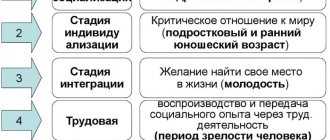Stress is good and bad: we understand the types and stages of development
In fact, stress helps our body; it is a natural mechanism that triggers the process of adaptation to any internal and external changes.
For example: You cut your finger - you experience stress, which makes your body understand that it’s time to leave the rescue team to heal the wound. or you have flown to a tropical country - stress tells the body what and how to change in order to more easily endure the heat and humidity.
However, stress can develop into a permanent state and then it becomes dangerous for your entire health and normal life.
Stress can be of two types: positive and negative.
Eustress and Distress
Eustress
The first form is eustress, which can be caused by both positive emotions (positive) and negative events (mobilizing).
In this state, a person is aware of his problems, his condition. The body mobilizes and concentrates on completing tasks. This occurs under the influence of adrenaline and other related hormones.
A person's activity increases. He successfully copes with assigned tasks at work and at home. But the resource of the human body is exhausted. Prolonged negativity leads to a destructive form.
Distress
Depletes the nervous system and destroys the body. Mental activity suffers, our performance decreases. Stress targets the immune system and attacks it. The body becomes vulnerable to various diseases.
Distress (from the English Distress) - grief, suffering, severe malaise, exhaustion.
Distress is divided into several subtypes
Physiological
The physiological type arises as a response to unfavorable internal factors and unmet physiological needs. They can be pain, hunger, thirst, abstinence. Negative environmental conditions also contribute. Cold, constant noise, and air pollution become stress for us.
Emotional
Our emotions can also cause stress. The emotional type is one of the most common types of stress. Even joyful events cause distress. It's all about prolonged emotional stress. It ultimately leads to psychological and moral exhaustion.
Short-term
The short-term type occurs as a response to a sudden strong impact. Manifests itself as fear and other reactions. It usually passes quickly and has no consequences, but can be deep and traumatic.
Chronic
The most severe and dangerous type is the chronic type. Negative factors influence us constantly. A person does not notice them, they become the “background”. However, ultimately, this “background” leads not only to nervous exhaustion, but also to illness, depression, and a general decrease in the quality of life.
Three stages of stress
G. Selye, a Canadian researcher and doctor, found that every body has the same reaction to stress, based on this pattern, he divided the whole process into 3 phases:
- Anxiety reaction
, in which all the protective functions of the body are mobilized. The body adapts to new conditions of existence. Thanks to the functional integration of organs and vital systems, senses such as memory, attention, touch, and perception are enhanced. The mobilization stage is characterized by the fact that during stress, the degree of thinking increases, options for solving the problem are found, and the person copes with the resulting load. Anxiety stage. - Resistance to imbalance
, when the body adapts to changes, and all parameters that were out of control at stage 1 are normalized. The individual gets used to the new atmosphere, but if it is difficult for the body to quickly adapt, and the resistance continues for a significantly long time, the last phase of stress begins. Resistance stage. - Exhaustion
occurs after unsuccessful attempts at adaptation, when physical strength is lost and the mental state begins to malfunction. This phase is divided into 2 stages.
Selye's stages of stress are clearly illustrated
The exhaustion stage under stress goes through two stages:
- At the stage of the disorder
, there is a decrease in performance, the level of thinking and perception decreases, and it becomes difficult to find a way out of the current circumstances. A person cannot adequately assess the situation and make any decision. This affects the results of work; creative thinking is replaced by simple repetition of action algorithms. If this process affects the management level, then impulsive demands on employees and inappropriate aggressive attacks towards them begin. Exit routes are randomly selected from the list that arose at the first stage of stress. - At the destruction
, all processes are inhibited. The person falls into numbness, it is difficult for him to concentrate on important things, he does not delve into the essence of the conversation, withdraws into himself and is more silent. This type of destruction is called hyperinhibition. This phenomenon can also develop in another “channel”, when a person, unable to find a place for himself, commits rash acts, his activities are disordered. He becomes withdrawn, it is difficult to shout or “reach out” to him. This type of stress is called hyperarousal.
During the exhaustion phase, various diseases appear that affect:
- gastrointestinal tract;
- cardiovascular system;
- mental condition;
- immunity;
- condition of hair, nails and skin.
Causes
The main reason is the situations that provoke it, they are called stress factors. Considering that the life of a modern person is dynamic and unpredictable, there are a great many reasons. Constant troubles, misunderstandings with loved ones, pressing stress at work, breakdowns of household appliances or cars, and just everyday worries. All this provokes irritation and anxiety.
Sometimes the lack of change, routine and “Groundhog Day” can be the main reason. Each person has their own individual mental characteristics, which for one is an annoying nuisance, for another a cause of stress.
Causes
Main reasons
- conflicts with family and friends;
- unemployment and debt;
- overwork, lack of vacation;
- chronic diseases and excess weight
- dissatisfaction with oneself and one's appearance
Stress develops at three levels: biochemical, psychological and physiological.
When a person finds himself in a stressful situation, his blood glucose level rises, blood pressure rises, the heartbeat becomes more frequent, the deposition of fatty tissue in the subcutaneous tissue increases, sodium is retained, and with it water in the tissues, and potassium, which is necessary for the functioning of the heart and nerves, is eliminated faster than necessary.
Types of people in stressful situations
Each person reacts to sources of stress individually; each phase can last longer or shorter for different people. This depends on a person’s resistance to stress, on his ability to quickly “bend under” the situation and find the right solution to solve the problem.
Experts have found that there are different reactions to stress and have identified 3 types of people:
- those who can withstand stress for a long time
, while being in excellent shape and in an adequate mental state; - those who, when a problem arises, lose their ability to work
, it is difficult for them to find a solution and adapt to new conditions; - those who can work productively and show high results only under stress
, problems “spur them on” and force them to move forward.
Psychological theories of stress
For the first time in 1915, American psychophysiologist Walter Bradford Cannon spoke about a condition that is now associated with the concept of stress, and called this reaction “fight or flight”. And he even described this phenomenon in the book “Body changes during pain, hunger, fear and anger.” The year 1915 can be considered the beginning of the European and American approach to this topic.
We recommend
“Nutrition for a healthy lifestyle: healthy foods, life hacks, menus” Read more
However, our compatriots found themselves on the same topic in the same years, and at the Military Medical Academy in St. Petersburg, Professor Korenchevsky in 1913 already described the adaptation syndrome and said that it is not a pathological, but a physiological reaction to cell damage, tissues, damage to some external environment.
The Austrian doctor Hans Selye graduated from the Medical University of Prague. Having moved to Canada, he studied the effects of the secretions of hormonal glands, which he obtained by crushing organs isolated from animals and injecting them into mice (not hormones at that time, because they were not isolated in their pure form).
He noticed a very interesting thing: no matter what hormone extract he injected into the mice, the reaction was very similar. There is a legend that one day he made some kind of technological mistake and forgot to untie his experimental mice and left them overnight.
And those mice that were injected with substances the day before and those that were not injected gave the same reaction in the form of ulceration of the gastric mucosa. The next day, some of the experimental subjects even died. And that’s when he first spoke about the general adaptation syndrome. Actually, this was the beginning of the story of stress.
Selye made very interesting conclusions that in fact only the intensity of the need for restructuring or adaptation matters. And the stimulus itself and the changes that led to the formation of this adaptation syndrome practically do not matter. The second conclusion that Selye made is that adaptive energy is available in limited quantities, given from birth.
Later, the American researcher Goldstone in 1952 entered into a debate with Selye and began to say that adaptive energy can be produced regardless of how much of it was given to the body at birth. It, of course, decreases in old age, but can remain in the form of adaptation capital.
Gradually, this topic began to develop from the organismic and cellular concepts, with which Selye began, into the social concept. From one experiment on mice, entire directions in biology, medicine, sociology and even politics related to the topic of stress have developed.
How to protect yourself from stress?
In modern society, escaping stress is a difficult task, but not hopeless. There is a rational approach: teaching skills to overcome stress and increase stress resistance. Regular morning exercises can help with this. And in the evening - relaxation classes, auto-training, yoga. Regular rest is also important, preferably in nature. Here are 10 simple but effective tips for those who want to learn how to overcome
stress on their own: 1. Try to
slow down the pace
of your life.
Plan your workday in advance; alternate periods of intense work with proper rest. 2. Get enough sleep! On average, an adult needs 7–8 hours of sleep
per day.
3. Don't eat on the go: breakfast, lunch and dinner should be a time of rest
.
4. Don't try to relieve stress with tobacco or alcohol. The problems that caused stress and the stress itself will not go away
, but your health will suffer.
Physical activity
will help relieve emotional stress : go swimming or water aerobics.
6. Set aside some time every day for relaxation
: sit in a comfortable chair, turn on some pleasant music, close your eyes and imagine that you are sitting on the seashore.
7. Try to distract yourself, switch to activities that give you positive emotions
: going to a concert, reading, walking in nature or chatting with friends.
8. There is no way to change the circumstances of life - change your attitude
towards them.
Carefully analyze your negative emotional experiences: perhaps the events that took place do not deserve such strong emotions. 9. Focus on the positive: The circumstances in your life are often better than you think
when you're upset.
Give yourself life: dealing with stress
How to recognize the signs of upcoming stress and deal with it? Evgenia Otradnaya, Evgenia Dobrovolskaya and our experts tell the story.
10. Watch your mood as you watch your appearance, treat your irritability and temper
as a source of illness
. A friendly facial expression and smile will improve your mood and the attitude of others towards you.
What is stress and why is it dangerous?
Stress is a state of increased tension in the body as a protective reaction to the influence of unfavorable factors (physical, psychosocial).
Almost all people have encountered stress in their lives. A significant proportion regularly experience physical symptoms associated with stress without even realizing it.
Stress awaits us everywhere - from an interview with an employer or a first date to a pile of unwashed laundry or an illness in a child. Stress itself is not always bad, because it allows us to invent individual ways of dealing with life’s difficulties, it makes us more mature, more seasoned, and smarter.
However, if stress is excessive or extremely prolonged, it can lead to the exact opposite result and turn our lives into a real nightmare. Stress that exceeds the body's adaptive capabilities is called distress. Distress leads to a breakdown of defense mechanisms and the occurrence of physical illness.
Often we don’t think about whether everything we do really needs to be done - or is it better to tell ourselves: “Stop.” We usually think that we are simply doing what any normal person would do in our place. This is precisely what can lead us down the path of chronic stress, folded into a gradually twisting tight spiral.









